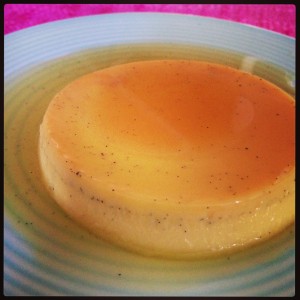I have a memory of watching my grandmother making caramel pudding in our kitchen at home. It might have been either my confirmation or my sister’s christening – since she was making it at our place and not her own. But it would also frequently be among the staples for dessert at Sunday dinner at her place.
For some reason, I’ve always imagined this to be super hard to make. It looks more impressive than it really is, as it is not that hard to make, I would say.
I took a look through my grandmother’s cookbook, Økonomisk kokebok (1936), and it actually looked rather easy. Plus, a lot of the technique is the same as what I’ve been doing when making the custard for the ice cream over the summer.
The ingredients below is what I used – but when it comes to the mixture of cream and milk I would say that it is really the matter of what you have in the fridge. I had a lot of cream that was about to expire – so I used more cream than milk.
It is also originally designed to be cooked in a bread pan – rectangular shape. But I thought it would be cute to have it in more single-serving dishes, and used individual ramekins.
It has to be made a bit in advance before serving, as it has to cool completely after being in the oven in order to set. Traditional Norwegian serving of this is with whipped cream, but it is really not necessarily, in my opinion.
Ingredients
600 ml mix of cream and milk. (I used 100 ml milk and 500 ml cream)
Seeds from 1 pod vanilla.
1 tbsp sugar
5 eggs
For the caramel
3 dl sugar
200 ml water
How to
- In a frying pan, cook the water and sugar for the caramel together. The sugar should dissolve, it should bubble, become a sticky mix, and the mix should turn slightly brown. (Depending on how dark you want your caramel.)
- Once you have caramel, add it to the bottom of your mould – whether it be bread pan, ramekins or something with more ornamental shape. Turn the caramel around in the mould until it covers the entire bottom of it. It will stiffen and set – which is how it should be.
- Turn the oven on to about 125 degrees Celsius.
- Start the custard by boiling milk and vanilla seeds for 8 minutes. Take it off the stove and let cool for a bit.
- While that is cooling, whisk the eggs and the tbsp of sugar together well.
- Add the milk and vanilla very gradually to the eggs while still whisking.
- Strain the custard. (It is not a required step, but I found that it lent itself to a very smooth result.)
- Add the custard on top of the caramel in the mould.
- Cook the mould in the oven in a water bath for 1- 1 1/2 hours.
- Take it out of the oven and cool completely before eating. (I accidentally ate one while still hot – and though it was utterly delicious, it had not set. I let the rest of the ramekins stand overnight, and some of them even stood in the fridge until the next evening)
- Just before serving, take a thin knife and cut carefully against the edges of the mould.
- Turn the mould around onto a serving platter, and remove the mould. The caramel should now be running down the sides.
- Serve.
